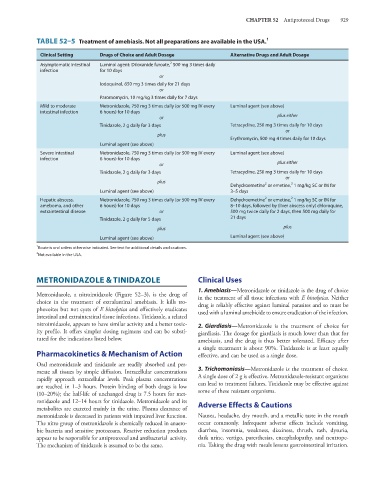Page 943 - Basic _ Clinical Pharmacology ( PDFDrive )
P. 943
CHAPTER 52 Antiprotozoal Drugs 929
TABLE 52–5 Treatment of amebiasis. Not all preparations are available in the USA. 1
Clinical Setting Drugs of Choice and Adult Dosage Alternative Drugs and Adult Dosage
2
Asymptomatic intestinal Luminal agent: Diloxanide furoate, 500 mg 3 times daily
infection for 10 days
or
Iodoquinol, 650 mg 3 times daily for 21 days
or
Paromomycin, 10 mg/kg 3 times daily for 7 days
Mild to moderate Metronidazole, 750 mg 3 times daily (or 500 mg IV every Luminal agent (see above)
intestinal infection 6 hours) for 10 days
or plus either
Tinidazole, 2 g daily for 3 days Tetracycline, 250 mg 3 times daily for 10 days
or
plus
Erythromycin, 500 mg 4 times daily for 10 days
Luminal agent (see above)
Severe intestinal Metronidazole, 750 mg 3 times daily (or 500 mg IV every Luminal agent (see above)
infection 6 hours) for 10 days
or plus either
Tinidazole, 2 g daily for 3 days Tetracycline, 250 mg 3 times daily for 10 days
or
plus 2 2
Dehydroemetine or emetine, 1 mg/kg SC or IM for
Luminal agent (see above) 3–5 days
2
2
Hepatic abscess, Metronidazole, 750 mg 3 times daily (or 500 mg IV every Dehydroemetine or emetine, 1 mg/kg SC or IM for
ameboma, and other 6 hours) for 10 days 8–10 days, followed by (liver abscess only) chloroquine,
extraintestinal disease or 500 mg twice daily for 2 days, then 500 mg daily for
Tinidazole, 2 g daily for 5 days 21 days
plus plus
Luminal agent (see above) Luminal agent (see above)
1 Route is oral unless otherwise indicated. See text for additional details and cautions.
2
Not available in the USA.
METRONIDAZOLE & TINIDAZOLE Clinical Uses
1. Amebiasis—Metronidazole or tinidazole is the drug of choice
Metronidazole, a nitroimidazole (Figure 52–3), is the drug of in the treatment of all tissue infections with E histolytica. Neither
choice in the treatment of extraluminal amebiasis. It kills tro- drug is reliably effective against luminal parasites and so must be
phozoites but not cysts of E histolytica and effectively eradicates used with a luminal amebicide to ensure eradication of the infection.
intestinal and extraintestinal tissue infections. Tinidazole, a related
nitroimidazole, appears to have similar activity and a better toxic- 2. Giardiasis—Metronidazole is the treatment of choice for
ity profile. It offers simpler dosing regimens and can be substi- giardiasis. The dosage for giardiasis is much lower than that for
tuted for the indications listed below. amebiasis, and the drug is thus better tolerated. Efficacy after
a single treatment is about 90%. Tinidazole is at least equally
Pharmacokinetics & Mechanism of Action effective, and can be used as a single dose.
Oral metronidazole and tinidazole are readily absorbed and per-
meate all tissues by simple diffusion. Intracellular concentrations 3. Trichomoniasis—Metronidazole is the treatment of choice.
rapidly approach extracellular levels. Peak plasma concentrations A single dose of 2 g is effective. Metronidazole-resistant organisms
are reached in 1–3 hours. Protein binding of both drugs is low can lead to treatment failures. Tinidazole may be effective against
(10–20%); the half-life of unchanged drug is 7.5 hours for met- some of these resistant organisms.
ronidazole and 12–14 hours for tinidazole. Metronidazole and its Adverse Effects & Cautions
metabolites are excreted mainly in the urine. Plasma clearance of
metronidazole is decreased in patients with impaired liver function. Nausea, headache, dry mouth, and a metallic taste in the mouth
The nitro group of metronidazole is chemically reduced in anaero- occur commonly. Infrequent adverse effects include vomiting,
bic bacteria and sensitive protozoans. Reactive reduction products diarrhea, insomnia, weakness, dizziness, thrush, rash, dysuria,
appear to be responsible for antiprotozoal and antibacterial activity. dark urine, vertigo, paresthesias, encephalopathy, and neutrope-
The mechanism of tinidazole is assumed to be the same. nia. Taking the drug with meals lessens gastrointestinal irritation.

